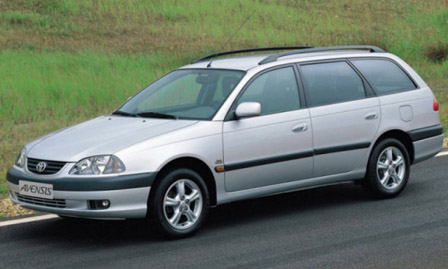 Toyota Avensis began its career halfway through 1997 year, replacing the Carina E, valued for its high quality and reliability. The new model was constructed like this, to meet the requirements of European middle class car users, and in parameters and properties it surpassed its predecessor. The vehicle has an elevated 2630 mm wheelbase, which allowed to design a spacious and comfortable interior, for four adults of a reasonable height. The rear seat, as in other cars of this class and size, hardly enough for three passengers. The interior has an ergonomic cockpit, allowing people of different shapes to take a comfortable position. It abounds in numerous storage compartments, np. for glasses above the rear view mirror or lockable in the armrests of the front doors. The driving comfort of the Avensis model is high. The noise from the engine and chassis are well muted, the suspension imperceptibly dampens minor unevenness, and with greater deflections of the suspension elements, there is no sway and galloping of the body. The inclination in the turns is not excessive and does not cause loss of vehicle control. The vehicle is stable to drive, has a well-chosen and precise steering system and effective brakes.
Toyota Avensis began its career halfway through 1997 year, replacing the Carina E, valued for its high quality and reliability. The new model was constructed like this, to meet the requirements of European middle class car users, and in parameters and properties it surpassed its predecessor. The vehicle has an elevated 2630 mm wheelbase, which allowed to design a spacious and comfortable interior, for four adults of a reasonable height. The rear seat, as in other cars of this class and size, hardly enough for three passengers. The interior has an ergonomic cockpit, allowing people of different shapes to take a comfortable position. It abounds in numerous storage compartments, np. for glasses above the rear view mirror or lockable in the armrests of the front doors. The driving comfort of the Avensis model is high. The noise from the engine and chassis are well muted, the suspension imperceptibly dampens minor unevenness, and with greater deflections of the suspension elements, there is no sway and galloping of the body. The inclination in the turns is not excessive and does not cause loss of vehicle control. The vehicle is stable to drive, has a well-chosen and precise steering system and effective brakes.
The equipment of the Avensis model surpasses the offer of competitors. They are the standard: two safety airbags (in the model 2.0 four), system ABS, electric windows of the front doors, central lock, electrically adjustable side mirrors and air conditioning. A car in the Wagon version (combi) It is powered by two 4-cylinder petrol engines with a timing gear 4 valves in the cylinder. Smaller displacement engine 1,6 dm3 ensures correct vehicle behavior in various road conditions, has good flexibility and is characterized by low fuel consumption. Its disadvantage is noisy operation in the higher RPM range. Second engine with a capacity 1998 cm3 offers very good traction parameters. It works evenly and quietly in the entire range of rotational speeds used. Uses a moderate amount of fuel on the road, it looks worse in the city, where the result below 9,5 dm3na 100 km should be considered a success.
A car with a universal body creates greater transport possibilities, often becoming a work tool. Avensis Wagon in this category is in the middle of the competition. Luggage compartment capacity (530/1610 dm3) it is enough to pack even large packages or items of considerable length. However, loading is difficult due to a fairly high threshold, which forms the lower edge of the loading opening. The width of the hold is significantly limited by the rear suspension strut housings and the load distribution in the car must be well planned. The rear seat, as in almost every car of this class, folds asymmetrically, and when unfolded, it provides a flat surface of the boot floor. Rope hooks are standard, immobilizing the transported load and railings, facilitating the installation of roof racks. The Toyota Avensis Wagon is approved for a 4-seater truck capable, according to the new regulations, to transport 505 kg load.
